Its capital is San José
San José is the capital of Costa Rica; it's known for its settlers such as "Chepe". Despite many people not wanting to visit, I am in love with my city, especially because it's where I was born and raised.
It's true that its cultural richness doesn't compare with that of European countries. However, they are many interesting places that keep secrets to the history of the city. In the same way, you can visit other attractions outside of the city. I will talk to you a little bit about them, and the activities that you can do there.
Attractions in the centre of San José
First of all, I'll give you a list of attractions that you can visit in the centre of San José (you can see the numbers on the map). There's something for everyone: 1. The National Theatre, 2. Melico Salazar Theatre, 3. Edificio Correos, 4. Central Market, 5. School Buenaventura Corrales, 6. The Yellow House, 7. National Stadium, 8. General Cemetery, 9. China Town, 10. the Amon neighbourhood, 11. the Escalante area, and the museums, 12. -National, 13. - de los Niños, 14. - de Jade, 15. - de Arte Costarricense, 16. - de Oro Precolombino y Numismática, 17. - de Arte y Diseño Contemporáneo, 18. - de Criminología, 19. - Ciencias Naturales La Salle, 20. - de Insectos y 21. - Dr. Rafael Calderón Guardia. Churches: 22. Metropolitan Cathedral, 23. Our Lady of Mercy. Plazas and parks: 24. Plaza de la Cultura, 25. Central Park, 26. Plaza de la Democracia, 27. Parque Morazan, and 28. Parque Metropolitano La Sabana.
As I couldn't possibly include all of the attractions in only one touch of the map, you can enter this website where you can see all the attractions I have mentioned:
https://drive.google.com/open?id=1mKFXwEk7nP0Rpxz9DxxmVgTNbOEJQI6u&usp=sharing
National Theatre
Because of its historical, patrimonial, architectural and cultural importance, it was declared to be a National Monument in 1965. It has an eclectic style, and its construction began in 1891 and finished in 1897. It's a building that us Costa Ricans are very proud of because of its historical value.
An interesting fact is that the construction was financed thanks to the establishment of obligatory tax for the exportation of coffee after 1890. For its construction, they used beautiful pieces of wood from the country, marble (from Italy), iron (from Belgium), gold and pieces of glass (from France), which were all imported.
It offers guided visits in Spanish and English that start every hour. Preferably you would be in a group of less than 30 so you can enjoy your visit to the maximum. Big groups have to book by filling out a form. For smaller groups or individual visitors you don't need a pre-booked reservation, but it is subject to availability.
For now, this is a photo that I have from the Theatre, it's not the best, it doesn't allow you to really appreciate its beauty. I went on the tourist bus, and they were restoring it, but it is what it is. At least I can give you an idea. If I find a better one I'll change it.
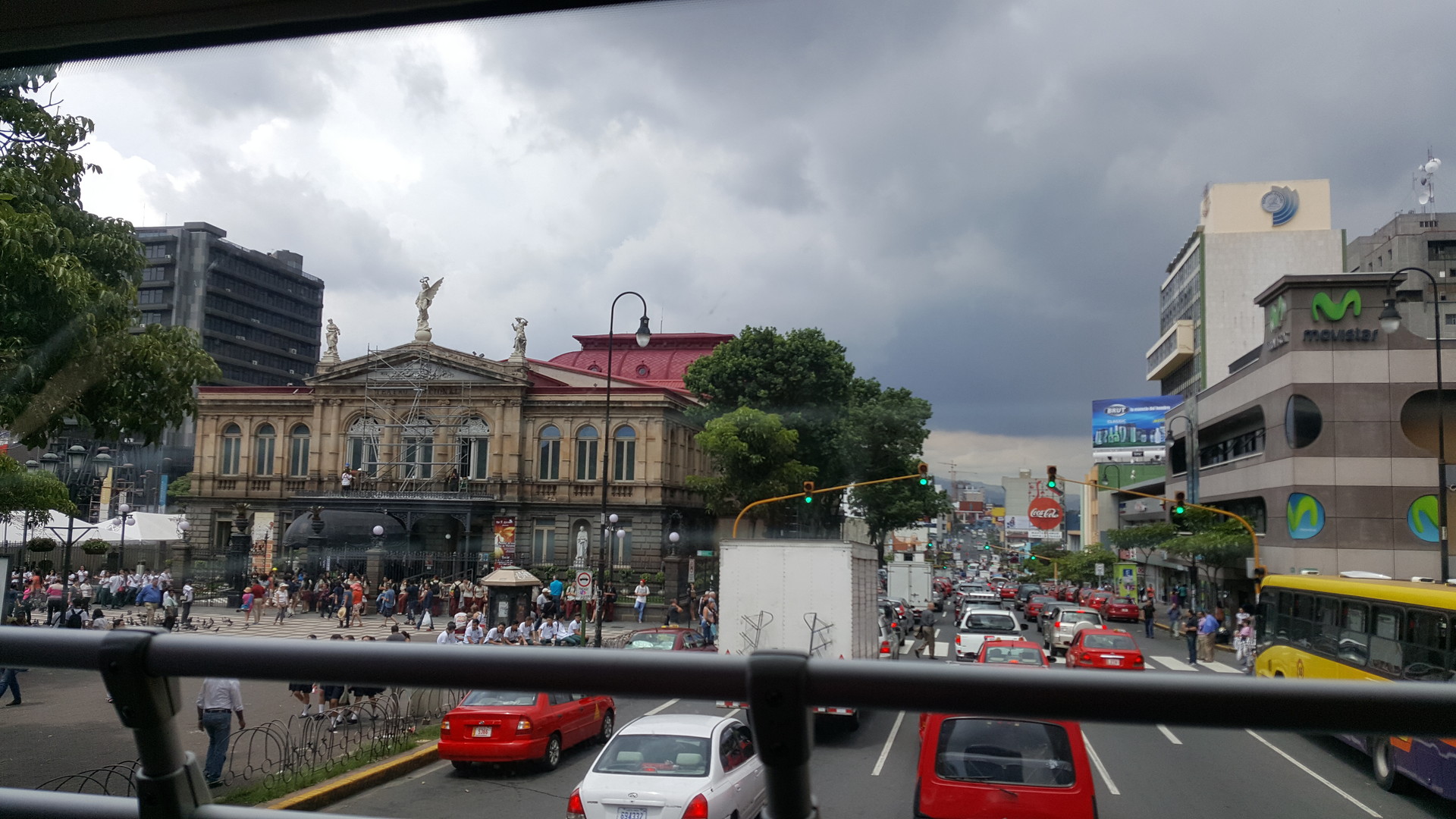
Source: My own photograph, 2016
Melico Salazar Theatre
Inaugurated in 1928, the land was bought by the Spaniard José Raventós as he wanted to create a place where he could enjoy operettas and shows. It's called Teatro Raventós.
In 1967 it was set on fire. The Ministry of Culture, Youth and Sports acquired and restored it. They celebrated its re-opening in 1981 (it was closed prior to this date) and the definite re-inauguration happened in 1985.
They christened it with its current name in honour of the famous Costa Rican tenor Melico Salazar Zúñiga. Its architecture is of a late Neo-classical style. The building was declared the historical Costa Rican architectural heritage in 1986.
Edificio Correos and Telegraphs
Of a similarly eclectic style, it was constructed in 1917. The building occupies a whole block in the city from north to south. It was declared the historical Costa Rican architectural heritage in 1980. On the inside, you'll find the Philatelic Museum which offers guided visits (this needs to be pre-booked).
Central Market
It opened in 1880, and it was the first municipal market of the country. Its architectural style is influenced by Neoclassicism. This building was declared the historical Costa Rican architectural heritage in 1995.
Inside you can acquire fresh produce, medicinal plants, handicrafts, t-shirts, you can try some traditional Costa Rican dishes, among other things. I would recommend the meat pot, the fruit salads and sorbets.
School Buenaventura Corrales
It's known as "the Metallic Building" because its structure is made from iron imported from Belgium in the year 1892. It's of a Neoclassic style.
It was constructed to house the "Graduated Schools", which were part of an education system that distributed students according to their age and knowledge in 3 distinct grades (elementary, average and advanced). They were also separated between two educational centres, one for women and one for men. Currently, it still functions as an educational centre, but with mixed sex classes.
Its name is in honour of Buenaventura Corrales, who was the official Mayor of the Secretary of Public Education in 1890. Corrales was the reason for its construction which, in 1890, was contracted by the Belgian architect Charles Thirion.
Yellow House
With a Neo-colonialist style, and some Neo-Baroque decorations, its name comes from the fact that the building is painted yellow. It was constructed in the year 1918 by the American architect Henry D. Whitfield, so that he could also install the Central American Court of Justice there; although an interesting fact that must be drawn to your attention, is that the Court never used this building because the agreement that was created at the time, had expired. In its place it became the Presidential House and the building was called Palacio de la Paz.
It was declared the heritage of Costa Rican historical architecture in 1976. It currently houses the offices of the Ministry of Foreign Affairs.
National Stadium
Thanks to the donation from the Chinese Government in 2008, they demolished the old stadium and constructed this world-class modern one. This new one opened in 2011.
It has an approximate capacity of 35, 000 seats and is the home of the Costa Rican national football team. According to some, it's the most modern football stadium and the one with the best technology in Central America and the Caribbean (for the moment).
It houses the sports museum and it has rooms for practising other sports, such as table tennis, fencing and chess. It offers guided visits.
General Cemetery
Its current location dates back to 1862, however, it was created in 1845.
It's of great historical importance because the remains of the past presidents of the Republic lie there, and people who stand out throughout the society and history of Costa Rica. Also, it stands out for its architectural beauty of its mausoleums and tombs, as well as its statues.
They distinguish themselves as constructions of the neo-classical, neo-gothic styles and eclectic and Egyptian influences. They say this as it has tombs constructed out of marble, bronze, stone and concrete. Because of this, in 2000 it was declared the heritage of Costa Rican historical architecture.
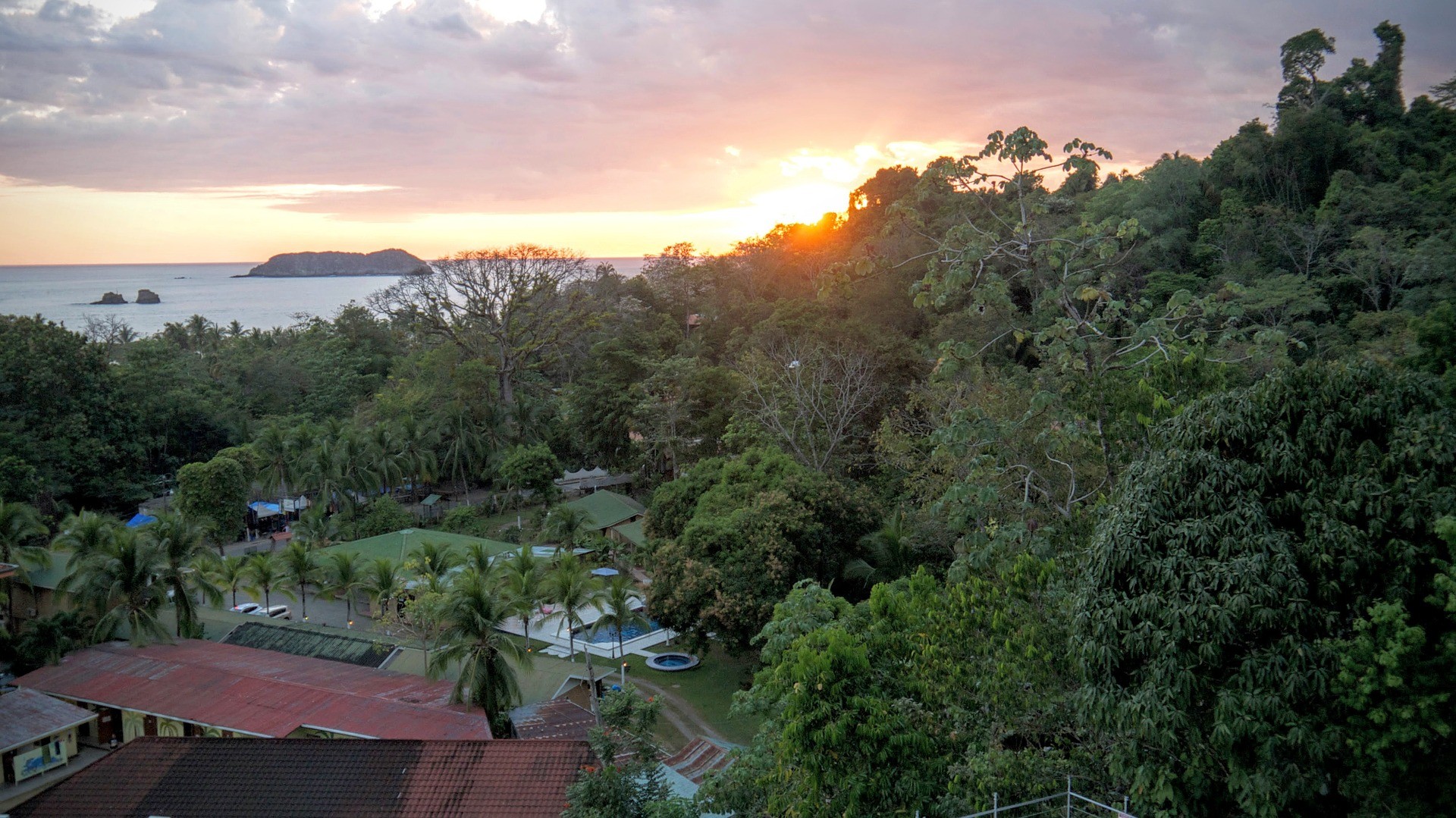
China Town
Opened in 2012. Its main entrance is located above the second avenue, at the intersection of street 9. This extends until avenue 14, where they erected the Confucio statue. This also includes street 7 and 11.
In truth, it's not like the traditional Chinatowns in other countries, as in a space that extends like this, you can find both Costa Rican shops and Chinese ones. They combine historical aspects - Costa Rican architectural features with traditional Chinese ones as well.
As a representation of that cultural co-operation, the main entrance is where Tang Arch is located and eight concrete spheres which symbolise the Costa Rican pre-Colombian spheres.
Calle 9 is called Paseo de los Estudiantes in honour of the students that study in the Liceo de Costa Rica, the Superior Girls' School and other educational institutions.
The Amón Neighbourhood
In 1982, the Frenchman Amón Fasileau-Duplantier proposed that the Municipality of San José create a neighbourhood in his name.
It was one of the first neighbourhoods that the coffee-growing and oligarch class of the country inhabited, consisting of both Costa Ricans and immigrants dedicated to businesses with railway projects, electrical companies, banana production, sugar cane and coffee, amongst others.
They have even conserved buildings with the same architectural styles, Victorian, Mudejar, Neoclassical and Eclectic, which is worth a visit.
The neighbourhood extends to the north of the city, up to the Torres rover and avenue 13. Towards the south until avenue 7, to the east until street 9 and to the west until Alfredo Volio street (street 0).
Escalante Neighbourhood
It was used as the coffee-growing plantation in the 19th century and at the beginning of the 20th century when they started to build the first buildings (1930). Its owner was a French immigrant Leonce Alphonse de Vars Du Martray who passed down the land to his daughters whose husbands had the surnames: Escalante and Robert.
Famous architects, academics, politicians, lawyers, painters, among other people lived in this area. The buildings are predominantly of a Neocolonialist style.
It's currently a mixture of a residential area with shops, educational and cultural centres, governmental offices, and more. But, it stands out because it has become an attractive and lively gastronomic area where you can enjoy a variety of drinks and dishes for every taste. Especially in street 33, which is known as the street of light, and its surrounding areas.
It extends to avenue 1 to the south, till avenue 17 to the north, and from street 23 to the west and street 37 to the east.
National Museum of Costa Rica
It was founded on the 4th May 1887. In 1950, they moved it to its current lcoation, in the Cuartel Bellavista. This building was constructed in 1917, to be used as the war barracks, until the abolishment of the army on the 1st December 1948.
During your visit, you can also enjoy some permanent collections that relay the History of Costa Rica from the 16th to the 21st century. There are temporary exhibitions from national and international artists. There's also a butterfly garden and virtual expositions.
They offer guided visits, studios, talks and sociocultural activities that you must book previously.
This museum is also dedicated to the investigation of natural history, anthropology and protection of heritage.
If you want to visit various museums, you can buy the Ticket "Paseo de los Museos": which includes the National Museum of Costa Rica, the Jade Museum, and the Central Bank Museums (Gold and Numismatics), which is valid for two months effectively, from the date of purchase.
Museum de los Niños
This building is of an architecturally Neogothic style. The building that houses the museum was constructed in 1907 and it ended up being used as a prison, which was named Central Penitentiary of San José and had disgraceful conditions until the year 1979.
It's currently occupied by the Costa Rican Centre of Science and Culture where you can find the National Gallery, the Museum de los Niños, the National Auditorium and the Juvenile Centre.
The Museum de los Niños is interactive, which is different to the other museums. Here you can touch, play and experiment with everything.
This museum is organised in distinct thematic sections such as The Universe, The Earth, Living Things, Human Beings, means of communication, playing in the city, physical sciences, playing with numbers and formulas, the Centre of Arts and exportation products that are relevant to the country such as coffee or bananas.
Museum of Jade
It was opened in 1977 under the name "Architectural Collection of the National Institute of Insurance. " In 1980 it changes its name to the Museum of Jade.
There are more than 7, 000 pieces that date back to 500 and 300 AC. The museum has archaeological, artistic and ethnographic collections.
The permanent collections are in 6 different rooms: the Dawn, Jade, the Day, Night, Memory and Collection.
They offer guided visits that you have to co-ordinate beforehand. They also have an audioguide service.
Museum of Costa Rican Art
It's located in a building of a neocolonial style, which was constructed at the end of the 30s and was the first international airport in Costa Rica.
The Museum was opened in 1978, with more than 6000 works of art, by national and international artists.
Its collection includes paintings, sculptures, photography and others that all date back from the middle of the 19th century all the way back to the beginning of the 21st century.
The visitor can enjoy three different area: the Golden Room, the Garden of Statues and the exhibition rooms. I'll leave you some photos of one of the walls with a mural in the Golden Room. This was made in 1940 by the Frenchman Luis Feron Parizot. It has a low prominence in plaster (the formula of the base is made of plaster cast), carved and painted in a bronze colour that sums up the history of Costa Rica from the pre-Colombian era until the year 1940.
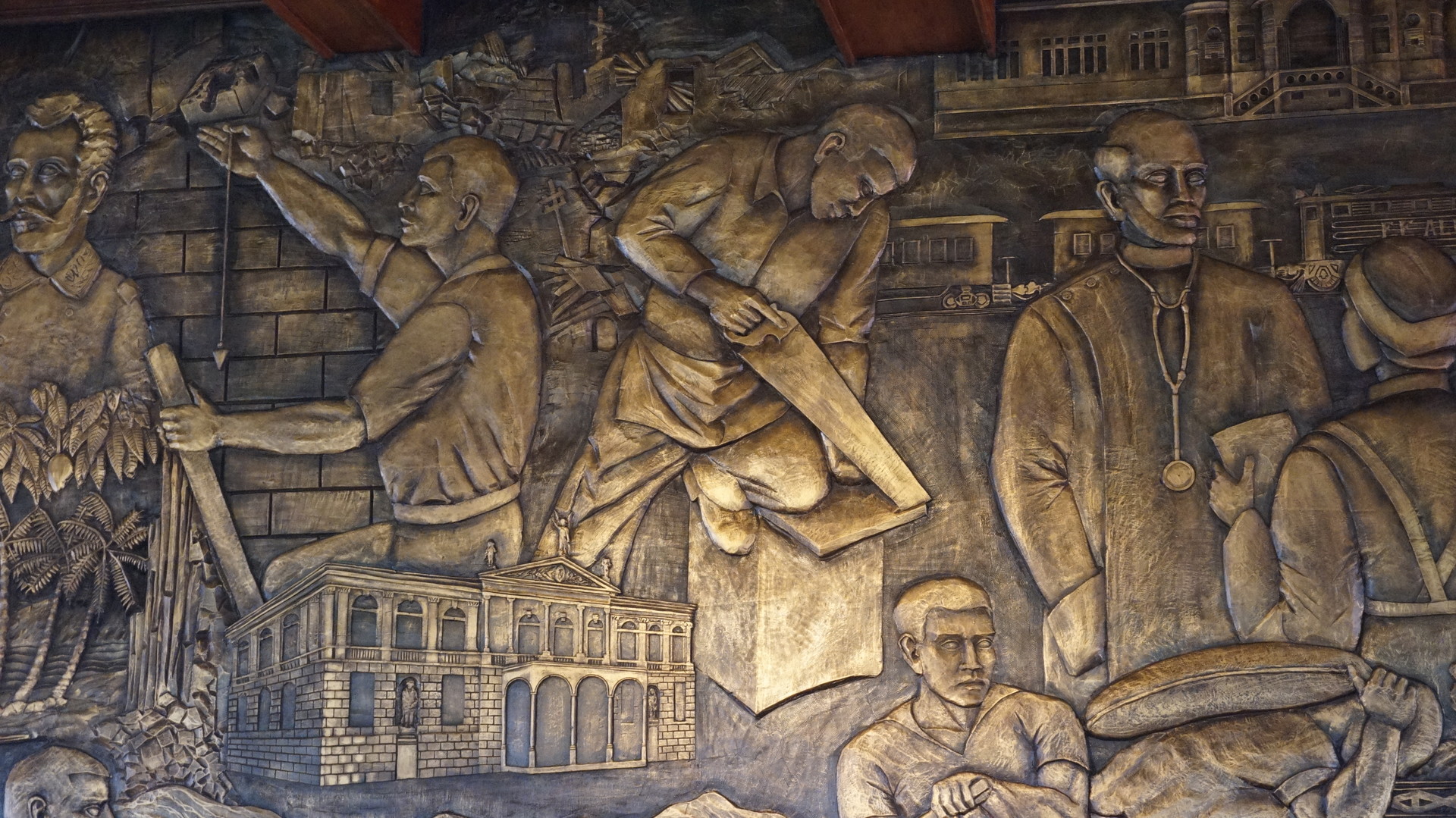
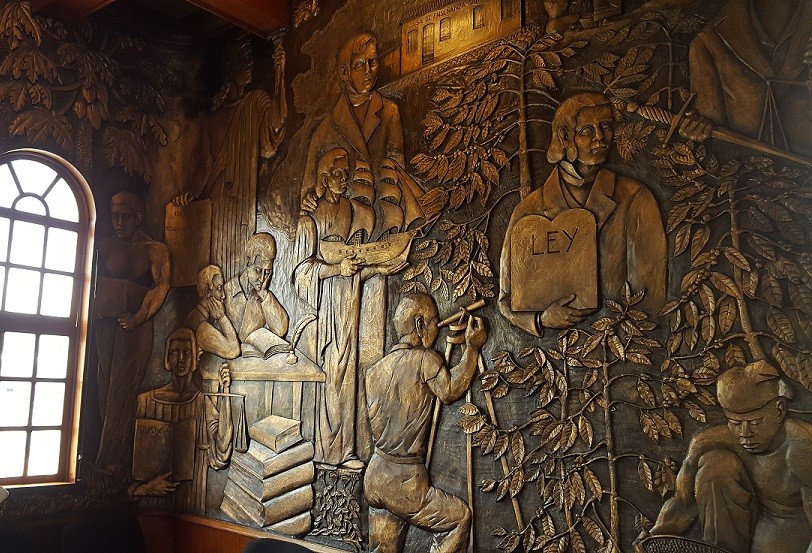
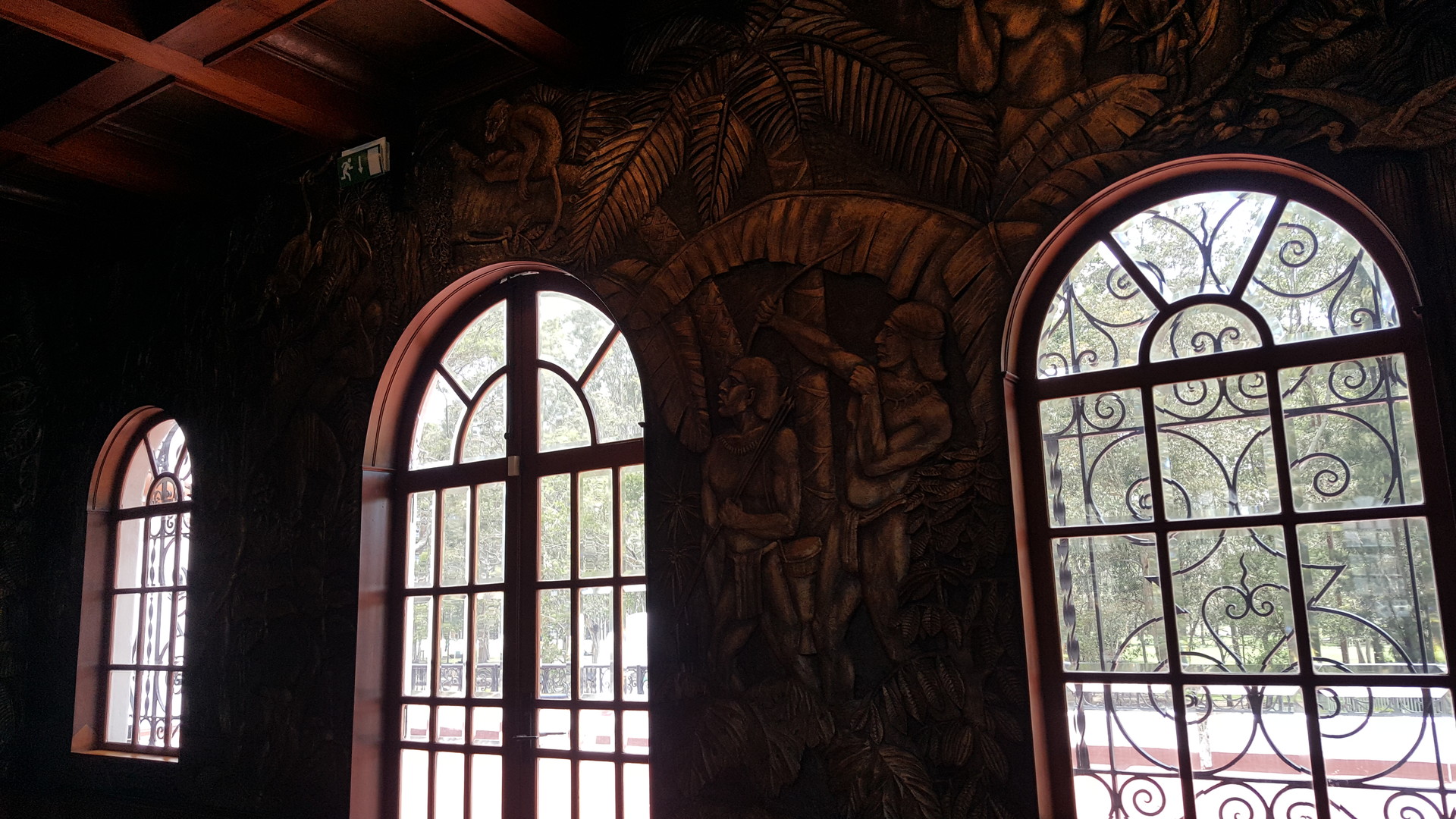
Source: My own photographs, 2016.
Museums of Pre-Colombian Gold and Numismatics
These are two collections which are known as the Museums of the Central Bank of Costa Rica.
Museum of Numismatics
It opened in 1990. The Central Bank of Costa Rica has a collection of currency from 1950. The collection includes currency that dates back to 1516 until nowadays, tickets distributed by different banking organisations and by the Government of the Republic from 1856 to today. There are also tickets to different coffee growing plantations and businesses that used this type of private money, die, documents and photographs.
Museum of Pre-Colombian Gold
They have collections of golden, ceramic and stone objects which come from different parts of the country. The collection of Pre-Colombian gold consists of more than 1, 500 pieces that date from the 6th to the 16th century. Additionally there is a small collection of ethnographic items which belonged to indigenous groups of people who inhabited the country. Their collections reflect the world view, social structure and the goldsmithing of the Costa Rican pre-colombian towns.
Currently, they are restoring the Museum of Gold as there is an alternative collection that offers reduced priced tickets.
Photo gallery
Content available in other languages
- Español: Su capital es San José
Want to have your own Erasmus blog?
If you are experiencing living abroad, you're an avid traveller or want to promote the city where you live... create your own blog and share your adventures!
I want to create my Erasmus blog! →




















Comments (0 comments)